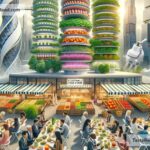The Future of Food and Inclusive Collaboration: A Recipe for a Better Tomorrow
Imagine a world where everyone has access to tasty, nutritious food and where the environment thrives alongside us. Such a future isn’t just wishful thinking—it’s possible, but it requires all of us to come together and work hand in hand. Food is more than just something we eat; it’s a way to connect cultures, fuel our bodies, and shape our planet. The future of food depends on both innovation and inclusive collaboration. Let’s explore how these two ingredients can create a better food system for everyone.
The Changing Face of Food
The food system is evolving. Over the years, advances in technology, farming methods, and science have transformed the way we grow, produce, and consume food. Today, we have opportunities to make food healthier, less wasteful, and more environmentally friendly.
By 2050, the global population is expected to reach nearly 10 billion people. Feeding this many people won’t be easy, especially as climate change puts pressure on farms and ecosystems. We need to rethink how we produce food to ensure that it’s abundant, sustainable, and affordable.
Here’s how food in the future might look:
– Lab-Grown Meat: Instead of raising animals for meat, scientists can grow meat in labs using animal cells. This process reduces greenhouse gas emissions and the land needed for farming.
– Plant-Based Proteins: Foods made from plants, like soy, peas, or mushrooms, are becoming tasty alternatives to traditional meat.
– Vertical Farming: Instead of relying on large fields, food can be grown indoors in stacked layers using controlled environments. This approach saves water and space.
– Food Waste Reduction: Innovations like smart packaging and better storage systems can help reduce the billions of tons of food wasted each year.
– Personalized Nutrition: By understanding genetics and individual needs, future diets might be tailored specifically to keep each person healthy.
While these advancements are exciting, they also come with challenges. Not everyone can access or afford new technologies, and some communities might worry about losing touch with traditional food practices. This is where inclusive collaboration becomes essential.
What Is Inclusive Collaboration?
Inclusive collaboration means everyone—farmers, scientists, policymakers, businesses, and everyday people—working together to shape the future of food. It’s about making sure every voice is heard, regardless of economic background, nationality, or age. Food impacts all of us, so it’s important to involve everyone in the conversation.
Why Collaboration Matters
The challenges of feeding the world aren’t limited to one country or one group. Hunger, climate change, and food waste are global problems. No single solution can fix everything, but when people work together and share ideas, big progress can be made.
Here are some ways inclusive collaboration can improve our food future:
1. Empowering Farmers: Farmers are at the heart of our food system, but many work hard without earning enough to support their families. Governments, organizations, and consumers can collaborate to create fair trade systems, provide better tools, and ensure small farmers succeed.
-
Respecting Local Traditions: Not all solutions will work everywhere. For example, lab-grown meat or high-tech farming equipment might not suit rural communities that depend on traditional farming practices. Collaboration means listening to local voices and finding solutions that fit unique cultures and environments.
-
Sharing Knowledge: Scientists constantly develop new ways to improve crops, conserve water, and fight pests. But this knowledge needs to be shared with those who need it most—especially farmers in developing countries—through education programs and open communication.
-
Reducing Food Inequality: Millions of people don’t have enough to eat, while others face obesity from poor diets rich in unhealthy foods. Governments, businesses, and advocacy groups can collaborate to make healthy food accessible to all, regardless of income.
-
Involving Young People: The next generation will inherit our food system, so it’s vital to include them in the conversation. Schools can teach kids about sustainable farming and healthy eating, inspiring them to find creative solutions for the future.
How Everyone Can Get Involved
You don’t need to be a farmer or scientist to shape the future of food. Each of us can play a part, no matter who we are. Here are some simple ways to get involved:
– Support Local Farmers: Buying from farmers’ markets helps small farms and supports sustainable agriculture.
– Waste Less Food: Plan meals carefully, save leftovers, and compost scraps to reduce waste.
– Choose Sustainable Options: Consider plant-based meals or foods grown responsibly to help the planet.
– Learn and Share: Stay informed about food issues and share what you learn with friends and family.
Looking Ahead Together
The future of food isn’t just about technology or innovation—it’s about people. Inclusive collaboration means combining everyone’s knowledge, creativity, and dedication to build a food system that works for all. When we listen to diverse voices and focus on solutions that unite rather than divide, we can create a world where everyone has enough and where the environment is protected for generations to come.
So, let’s work together to build this brighter future. Food is something we all share, and the power to change it lies in our hands. By supporting each other, embracing new ideas, and respecting our differences, we can create a recipe for success that feeds not just our bodies, but also our dreams for a better world.

